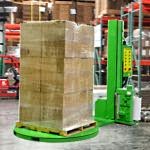There are two ways to apply stretch wrap - by hand and with a machine. While there are many variables to consider when determining if you need a stretch wrap machine, here are the primary considerations:
 |
| Highlight Predator XS |
- How many pallets per day (or per hour) do we typically wrap?
If you wrap more than four loads per hour, or over 30 per day, then a stretch wrap machine would be a good investment. A stretch wrap machine can be cost-effective even if you wrap as few as 10-15 loads per day. The more loads you wrap per day, or per hour, the more sense it makes to invest in a stretch wrap machine. - How much prestretch is required to effectively secure your load?
The average person using hand wrap can attain a consistent prestretch of maybe ten percent. Stretch wrap can attain a prestretch of over 250 percent, depending upon the type of film and the machine being used. The higher the amount of prestretch, the more the film is stretched, the more tightly the load is secured, and the more loads you can wrap with one roll of film. - How much time is being spent wrapping by hand?
This is a subjective variable, but a stretch wrap machine can literally enable your worker to press a button and let the machine finish the job while they tend to other tasks. - Safety
By eliminating the need to hand wrap, a stretch wrap machine can dramatically increase employee safety. There is no need to walk multiple times around a load, most of that time being spent bent at the waist holding a roll of stretch wrap. One stretch wrap machine can certainly be more cost effective than one worker's comp claim - both in terms of time and money.
If your business manufactures or fabricates products you might have purchased equipment in the past such as an hoist, or a workstation jib crane so you might be familiar with the process of procuring capital equipment. If you've only and always used hand wrap, the cost of a stretch wrap machine (usually starting at around $6,000) can be intimidating. But the purchase of a stretch wrap machine can be most accurately be looked at as an investment, rather than simply an expense. A stretch wrap machine can offer you significant savings in the following ways:
 |
| Highlight Predator SS |
- Film Savings
As mentioned above, the average worker using hand wrap can typically achieve no more than 10% prestretch. A stretch wrap machine, however, can achieve over 250% prestretch, depending upon the film and the machine. Prestretch simply refers to how much the film is stretched. The greater the film is stretched, the less film you are using, and the more loads you can wrap with one roll of film. (see table below) - Time Savings
Depending upon the size of the load, it can take one employee as much as three or more minutes to wrap one load. If they're wrapping 20 loads per day, for example, that's 60 minutes - or one hour - spent wrapping. With a semi-automatic stretch wrap machine, that time can be spent doing other things rather than walking in circles around a pallet. - Safety
As noted above, the cost of one stretch wrap machine can be significantly less than the monetary and time expense of one worker's comp claim filed due to back or other injuries sustained by using hand wrap.
Another way of looking at it is that with one pallet of 80ga 20" machine film (40 rolls) you can wrap approx 2750 loads (assuming 150% stretch). With one pallet of 80ga 18" hand wrap (192 rolls, or 48 cases) you could wrap only 1690 loads. No matter how you look at it, using a stretch wrap machine will save you money and time in the long run.
If the cost is still a problem for your budget, consider using the Section 179 tax deduction when you file your taxes. This can help cut your end cost by close to forty percent.
If the cost is still a problem for your budget, consider using the Section 179 tax deduction when you file your taxes. This can help cut your end cost by close to forty percent.
How Do I Select a Stretch Wrap Machine?
You will need to know the following information in order to determine what stretch wrap machine will work best for your packaging needs:
 |
| Highlight Freedom 6500 Rotary Arm Wrapper |
- Minimum, average, and maximum load weights
- Maximum load height
- Maximum load width/depth
- The average number of loads per day, or per hour, you typically wrap
- The nature of the product(s) being wrapped
- The width film do you intend to use
- If you will be loading the machine with a forklift only or a pallet jack as well
- If you need an integrated scale
- The color stretch wrap you use (this can affect the photo-sensor eye)















